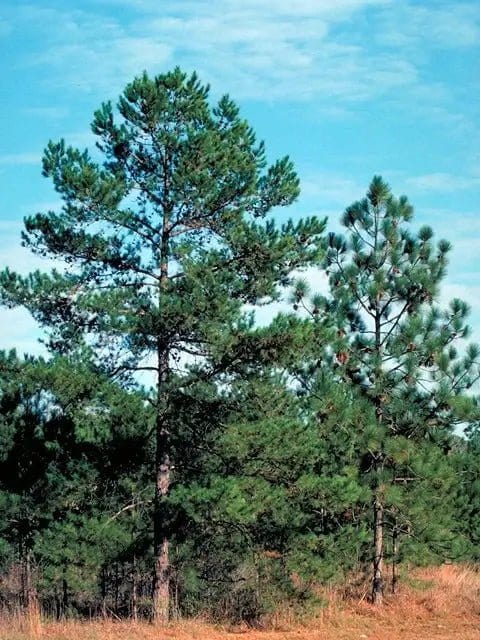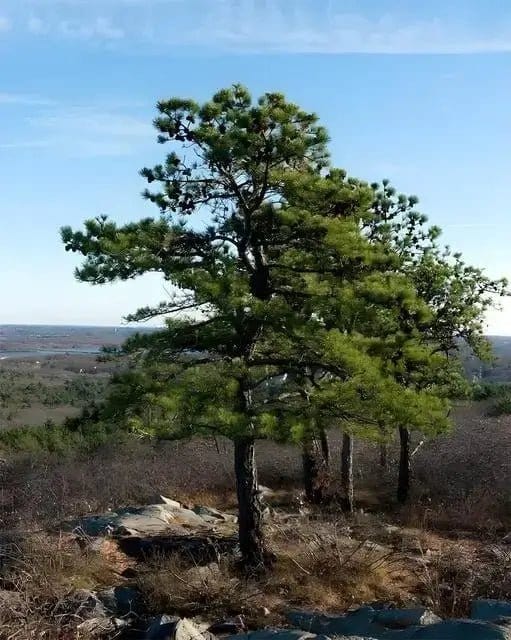Pitch Pine Tree
Pitch Pine Tree
| Order | Percentage Discount | ||
|---|---|---|---|
| 2-5 | 25% Off | ||
| 6-10 | 30% Off | ||
| 11-25 | 35% Off | ||
| 26-50 | 45% Off | ||
| 51+ | 65% Off | ||
Couldn't load pickup availability
5-7 Days
Over 25 Feet
Full Sun
4-7
Evergreen
Bare-root
MT. AL. CT. HI. UT. WI. TX.
Pitch Pine Tree - Pinus Rigida
The Pitch Pine Tree is a popular choice for adding elegance to any landscape. With its unique bark texture, vibrant green needles, and ability to thrive in various soil types, it is easy to see why this tree is so highly sought-after. Here, we will discuss the features and benefits of this stunning tree and how it can be a perfect addition to your landscape.
Tree Characteristics
The tree is known for its distinctively red-brown bark, which peels off in plates to reveal a smooth, reddish-orange surface. This unique bark texture, combined with its dark green needles, gives the tree a distinctive look that will catch the eye. The hands are usually between 3 and 5 inches long, and the tree can grow up to 50-60 feet tall, making it an excellent option for providing shade.
Benefits Of Pitch Pine Tree
Aside from its stunning appearance, the tree has many benefits, making it an ideal addition to any landscape. This tree is highly adaptable to different soil types and can even thrive in poor soil conditions. It is also highly resistant to pests and diseases, making it a low-maintenance option for any landscape. Additionally, the tree provides valuable habitat for wildlife, such as birds and squirrels.
Planting and Care
The tree is relatively easy to plant and care for, making it an excellent option for those new to landscaping. It thrives in full sun to part shade and prefers well-draining soil. Watering should be done regularly during the first few years after planting to help establish the tree's root system. Pruning can be done as needed, but not for the tree's health.
These trees are stunning, low-maintenance landscape additions. With their unique appearance and ability to thrive in various soil conditions, it is easy to see why they are such a popular choice among landscapers and homeowners alike. Whether you want to add shade to your yard or enhance the beauty of your landscape, the tree is a great option.
Pin oak is a beautiful choice if you're looking for a rapidly growing tree that will add visual appeal to your yard. It thrives in full sun and is suitable for zones 3-9.
They are drought-resistant, so you won't have to worry about the trees wilting if you live in an area that doesn't get much rain. These pines are also ideal as borders since the lush green leaves add an element of privacy to your property. The trees are also deer-resistant, so your tree will remain intact when deer visit your yard.
This pine also tolerates several soil conditions, but it's best to keep the soil filled with nutrients and well-drained when possible. The tree has drooping branches that twist around each other, giving it a globe-like shape. The needle-like leaves grow in groups of three. The trees are stiff and yellowish-green in color.
The tree also produces pine cones that grow in groups of five or three. The trees grow under 20 feet at maturity and keep their leaves all year, making them an attractive addition to your front or backyard. The trees should be planted together to form a hedge and can make for a great wind break.
Growth and Planting
During the spring and summer, birds gather in the trees to make your landscape more enticing. Small mammals like squirrels and chipmunks favor this tree and feed on the sprouts and seeds of the tree.
These trees are easy to care for, making them perfect for residential and commercial spaces. The tree can also be used for fuel, specific construction jobs, and pulp. You can also extract pitch from the tree, which is how the pine got its name.
This Is How Your Plants Will Look upon Delivery
Shipping date depends on the date displayed and chosen when you order from the product's page.
We only accept returns on plants verified dead. If you think your plants have died, we offer a 1 year warranty, please use use this File a Claim Link to verify dead plants and start with return warranty process.




